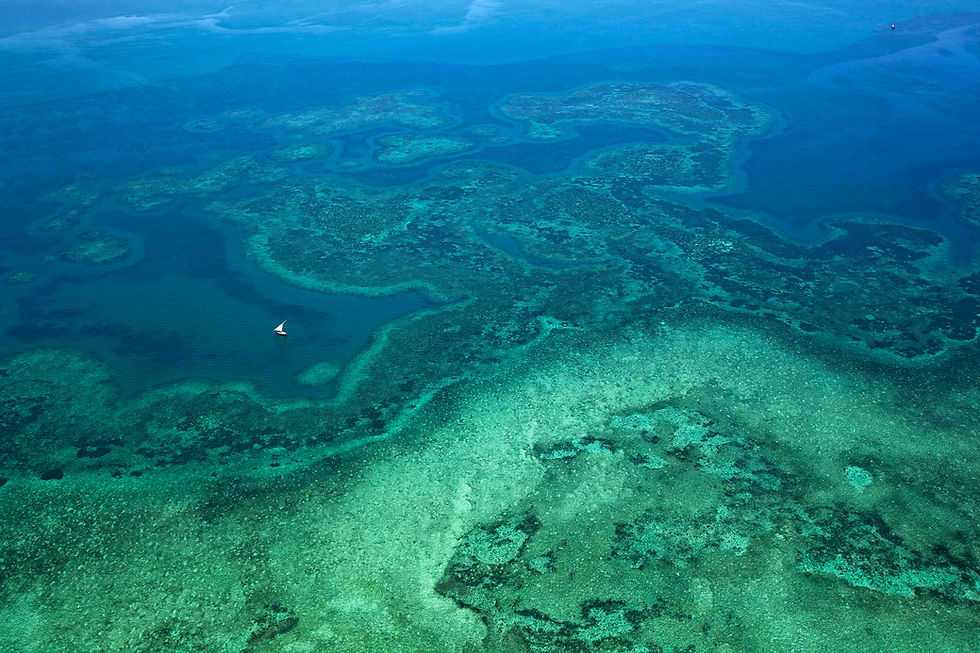
Nothing can prepare you for your first flight over the shimmering seas surrounding the small limerick of islands evocatively known as the Bazaruto.
Leaving behind the palm fringes and alabaster shores of Vilanculos, one enters a parallel universe; a vast canvass of blues as beautiful as they are surreal.
Iridescent ribbons of cobalt and cerulean curl through low tide sand shoals dotted in cheerful wooden fishing dhows; butterfly sails toing and froing on an Indian ocean breeze.

This grand oceanic tapestry is home to a plethora of life and it is not unusual to spot giant manta, stingray, whale shark, hammerhead and more rarely, the illusive Dugong from above.
The Dugong, mermaid of the seas; is a creature steeped in myth and legend. Once ranging from Ethiopia to southern Mozambique, they have now found their last refuge in the sea grass meadows within the Bazaruto Marine Reserve. Protected from the indifferent plundering of commercial fishing by the fervent efforts of The Endangered Wildlife Trust and more recently by African Parks, it is here where these gentle grazers endure.

The best time to fly the Bazaruto is at low tide when the retreating sea exposes millions of sand spits and tiny isles of dazzling white sand set in radiating swirls of vivid blue. In the Portuguese era, so the story goes, convicts would be shackled together and left here to drown with the rising tide.

Further north, the monsoon winds seem to bring with them memories of a grand and turbulent past. This is the east coast of Africa; epicenter for centuries, of the relentless pursuit of wealth and dominance by the Dutch, Portuguese and Arabs. The trade of slaves, gold, ivory and spices dominated this coastline from as early as the fifteenth century with Ilha de Moçambique, the seat of colonial Portuguese East Africa at its center.

Ilha de Moçambique, a diminutive crescent shaped island with a larger than life past measures only three kilometers in length and 600 meters across at its widest point. A UNESCO world heritage site, the island exudes an old world charm that rivals Zanzibar in its authenticity and charm. Nothing quite matches the faded glory of Ilha de Moçambique still populated with the remains of colonial fortresses, churches and mansions tracing their history back five centuries. Time seems to have its own agenda here, with wooden fishing dhows gliding beneath lateen-rigged sails on a tranquil backdrop of Indian Ocean life that seems to have been unchanged for centuries.
In the early 1500’s the Portuguese established a port and naval base on the island and built the Chapel of Nossa Senhora de Baluarte now considered the oldest European building in the Southern Hemisphere. The intimidating Fort of São Sebastião followed and allowed the Portuguese to withstand a multitude of attacks and assure that the island remained a major trade post for years to come.
It was only with the opening of the Suez Canal, that the island's fortunes waned. In 1898, the capital was moved to Lourenço Marques (now Maputo) on the mainland.

Further north still, is Ibo, the best known of the Quirimbas islands, a surreal and alluring place and one of the nation's historical highlights. Its quiet streets are lined with dilapidated villas and crumbling, moss-covered buildings that echo with the footsteps of bygone centuries.

At the island’s northern end is the star-shaped Fort of São João Baptista, built in 1791 and designed to accommodate up to 300 people. When Ibo was linked to the slave trade, the fort’s dark, cramped lower chambers were used as slave holding points. Today the fort is known for the silver artisans who have set up shop near the entrance. Much of the silver they use comes from melted-down coins, but the unique, refined Swahili artisanship is among the finest one will find anywhere.


This long and convoluted history, the turbulence, the tragedies, the wars and the grandeur of a time gone by all pale into insignificance when gliding at 1000ft over what must be one of the most pristine coastlines on earth, with its long, dune-fringed beaches, turquoise waters teeming with life, spectacular coral reefs, remote archipelagos, pounding surf, flamingo studded lagoons and graceful dhows.


Meanwhile, on terra-firma, away from the esoteric musings brought on by flight, exploring this sun-sparkled jewel of a country by foot, vehicle or dhow allows one to get a better understanding of the unique environments and traditional cultures of Mozambique. The soporific Indian ocean days meld into each other; a waking dream of sand and sea. Catching a dhow for a snorkel and an afternoon doze under a palm tree is a must, watching young fishermen, bodies sleek and toned practicing capoeira dancing on the beach at sunset completely captivating, contemplating the vagrancies of the ocean as it swells and recedes a beautiful meditation.

This a place where time moves slowly; and although there is always something to keep the restless intrigued; horse riding, snorkeling, fishing, kite surfing, gastronomy and the colorful larger than life inhabitants of this unique shore; it is here that one catches glimpses of the old ways, far away from the rat race of cities and the wild perambulations of the mind.
To join us on an aerial safari or aerial photographic workshop exploring this unique coastline please visit www.aerial-africa.com
ABOUT THE AUTHORS

Flying thousands of hours in their specially modified aircraft, aerial photographers Jay and Jan Roode have spent more than a decade photographing some of the most remote and spectacular wilderness areas of Southern Africa from above.
The continent of Africa has always held an irresistible allure and fascination for them and they seem content only when free to roam the
skies, capturing awe inspiring images of the
natural wonders of the region from above.

Comments